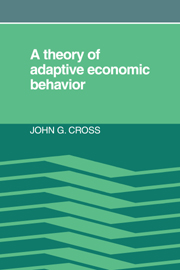Book contents
- Frontmatter
- Contents
- Preface
- 1 Introduction
- 2 Models of convergence
- 3 Behavior in the short run
- 4 Uncertainty
- 5 An application to state lottery games
- 6 An application to the problem of search behavior
- 7 Inflationary disequilibrium
- 8 Advertising and imitation
- 9 An application to migration
- 10 Conclusions
- References
- Index
6 - An application to the problem of search behavior
Published online by Cambridge University Press: 07 October 2011
- Frontmatter
- Contents
- Preface
- 1 Introduction
- 2 Models of convergence
- 3 Behavior in the short run
- 4 Uncertainty
- 5 An application to state lottery games
- 6 An application to the problem of search behavior
- 7 Inflationary disequilibrium
- 8 Advertising and imitation
- 9 An application to migration
- 10 Conclusions
- References
- Index
Summary
It has never been easy to use conventional microeconomic theory to explain how it is possible for apparently identical commodities to sell in the same market at widely different prices in different stores. Nevertheless, examples of the phenomenon are commonplace, and striking cases of price variation can be acquired with almost no difficulty. It took the author only half an hour with a telephone and a copy of the New York Times to discover that a piece of camera equipment in which he was interested could be obtained by mail from New York for $125.00, from a retailer in Ann Arbor, Michigan, for $182.00, and from another store in the campus area for $234.00 (these prices included taxes and shipping, and warranty and repair services were identical). It is understandable that a retailer with better service or with a more convenient location might be found to be charging a higher price, but the $57.00 difference between local outlets is many times the cost of a telephone call plus taxi fare from one store to the other, and that a significant number of rational consumers would pay over $100.00 extra in order to avoid a few days delay for a mail order is quite unbelievable.
Following the lead of Professor Stigler's 1961 article on the economics of information, economists have generally addressed the problem of price variation by suggesting that consumers are uninformed as to the prices charged by various “stores” and that the presence of high search costs prevents rational consumers from uncovering all the information that would be required for full optimization.
Information
- Type
- Chapter
- Information
- A Theory of Adaptive Economic Behavior , pp. 100 - 130Publisher: Cambridge University PressPrint publication year: 1983
